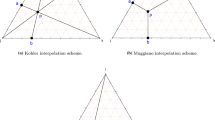Abstract
The Lippmann diagram for the system(Ba, Sr)SO4-H2O was computed at 25 °Cby determining the solid-phase activity coefficientsfrom first principles calculations. Directcalculations of the mixing properties of thebarite-celestite series indicate this solid solutionbehaves as non-ideal and non-regular. At 25 °C,the enthalpy of mixing shows a minimum around 50 mole% SrSO4 due to an ordering tendency. Thefree energy of mixing shows two minima that delimit awide and symmetric miscibility gap (from 2.1 to 97.9 mole% SrSO4) at this temperature. The excessfree energy of mixing requires a Guggenheim expansionseries of 5 terms to be described, where the termswith odd exponents are null as a consequence of thesymmetric distribution of the mixing properties withcomposition. The Lippmann diagram shows a peritecticpoint that corresponds to the composition of an aqueoussolution which is simultaneously at equilibrium withthe two extremes of the miscibility gap. The largedifference between the solubility products of theendmembers involves a strong preferential partitioningof the less soluble endmember towards the solid phase,which explains the extremely Ba-poor composition ofthe aqueous solution (aqueous activity fraction forBa2+ = 0.000446 ) at the peritectic point.
Similar content being viewed by others
References
Allan, N. L., Rohl, A. L., Gay, D. H., Catlow, R. A., Davey, R. J. and Mackrodt, W. C (1993). Calculated bulk and surface properties of sulfates. Faraday Discuss 95, 1–7.
Baldasari, A. and Speer, J. A. (1979). Witherite composition, physical properties and genesis. Amer.Mineral. 64, 742–747.
Becker, U., Fernández-González, A., Prieto, M., Harrison, R. and Putnis, A. (1999). Direct calculation of the mixing enthalpy of the barite/celestite system. Physics and Chemistry of Minerals (in press).
Blount, C. W. (1977). Barite solubilities and thermodynamic quantities up to 300°C and 1400 bars. Amer.Mineral. 62, 942–957.
Brower, E. and Renault, J. (1971). Solubility and enthalpy of the barium-strontium sulfate solid solution series. New Mexico State Bureau of Mines and Mineral Resources, Circular No. 116.
Casey, W. H., Chai, L., Navrotsky, A. and Rock, P. A. (1996). Thermochemistry of mixing strontianite [SrCO3(s)] and aragonite [CaCO3(s)] to form Ca1-xSrxCO3(s) solid solutions. Geochim.Cosmochim.Acta 60, 933–940.
Chang, L. L. Y. (1971). Subsolidus phase relations in the aragonite-type carbonates I. The system CaCO3-SrCO3-BaCO3. Amer.Mineral. 56, 1660–1673.
Gale, J. (1998). GULP (General Utility Lattice Program), Imperial College/Royal Institution of Great Britain.
Galinier, C., Dandurand, J. L., Souissi, F. and Schott, J. (1989). Sur le caractère non-ideal des solutions solides (Ba, Sr)SO4: mise en évidence et détermination des paramètres thermodynamiques par des essais de dissolution à 25°C. Comptes Rendus de l'Academie des Sciences, Serie 2, Mécanique, Physique, Chimie, Sciences de l'Univers, Sciences de la Terre 308 1363–1368.
Glynn, P. D. (1990). Modeling solid-solution reactions in low-temperature aqueous systems, in D. C. Melchior and R. L. Bassett (eds.), Modeling in Aqueous Systems II, Amer Chem. Soc. Symposium Series, Vol. 416, pp. 74–86.
Glynn, P. D. and Reardon, E. J. (1990). Solid-solution aqueous-solution equilibria: thermodynamic theory and representation. Amer.J.Sci. 290, 164–201.
Guggenheim, E. A. (1937). Theoretical basis of Raoult's law. Transactions of the Faraday Society 33, 151–159.
Hanor, J. S. (1968). Frequency distribution of composition in the barite-celestite series. Amer.Mineral. 53, 1215–1222.
Kornicker, W. A., Presta, P. A., Paige, C. R. and Johnson, D. M. (1991). The aqueous dissolution kinetics of barium/lead sulfate solid solution series at 25 and 60°C. Geochim.Cosmochim.Acta 55, 3531–3541.
Lippmann, F. (1977). The solubility product of complex minerals, mixed crystals and three-layer clay minerals. N.Jb.Mineral.Abh. 130, 243–263.
Lippmann, F. (1980). Phase diagrams depicting aqueous solubility of binary carbonate systems. N.Jb.Mineral.Abh. 139, 1–25.
Malinin, S. D. and Urusov, V. S. (1983). The experimental and theoretical data on isomorphism in the (Ba, Sr)SO4 system in relation to barite formation. Geokhimiya 9, 1324–1334.
Navrotsky, A. (1987). Models of crystalline solutions. Rev.Mineral. 17, 35–69.
Plummer, L. N. and Busenberg, E. (1987). Thermodynamics of aragonite-strontianite solid solutions: results from stoichiometric dissolution at 25 and 76°C. Geochim.Cosmochim.Acta 51, 1393–1411.
Prieto, M., Fernández-González, A., Putnis A. and Fernández-Díaz, L. (1997). Nucleation, growth and zoning phenomena in crystallizing (Ba, Sr)CO3, Ba(SO4,CrO4), (Ba, Sr)SO4, and (Cd, Ca)CO3 solid solutions from aqueous solutions. Geochim.Cosmochim.Acta 61, 3383–3397.
Reardon, E. J. and Armstrong, D. K. (1987). Celestite (SrSO4(s)) solubility in water, sea water and NaCl solutions. Geochim.Cosmochim.Acta 51, 63–72.
Redlich, O. and Kister, A. T. (1948). Algebraic representation of thermodynamic properties and the classification of solutions. Industrial and Engineering Chemistry 40, 345–348.
Stipp, S. L., Hochella, M. F., Parks, G. A. and Leckie, J. O. (1992). Cd2C uptake by calcite, solid-state diffusion, and the formation of solid-solution: Interface processes observed with near-surface sensitive techniques (XPS, LEED, and AES). Geochim.Cosmochim.Acta 56, 1941–1954.
Tesoriero, A. J. and Pankow, J. F. (1996). Solid solution partitioning of Sr2C, Ba2C, and Cd2C to calcite. Geochim.Cosmochim.Acta 60, 1053–1063.
Thorstenson, D. C. and Plummer, L. N. (1977). Equilibrium criteria for two-component solids reacting with fixed composition in an aqueous-phase; example: the magnesian calcites. Amer.J.Sci. 277, 1203–1223.
Waldram, J. R. (1985) The Theory of Thermodynamics, Cambridge University Press, Cambridge.
Author information
Authors and Affiliations
Rights and permissions
About this article
Cite this article
Prieto, M., Fernández-González, A., Becker, U. et al. Computing Lippmann Diagrams from Direct Calculation of Mixing Properties of Solid Solutions: Application to the Barite-Celestite System. Aquatic Geochemistry 6, 133–146 (2000). https://doi.org/10.1023/A:1009642619137
Issue Date:
DOI: https://doi.org/10.1023/A:1009642619137




